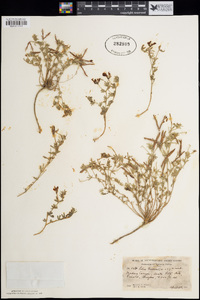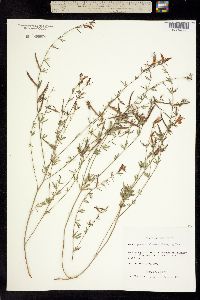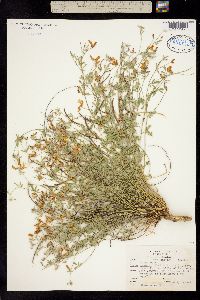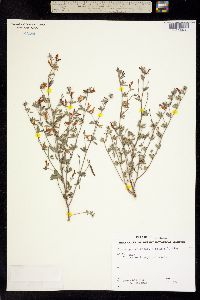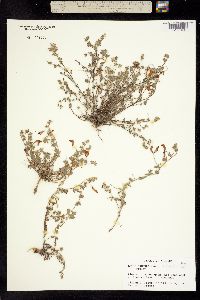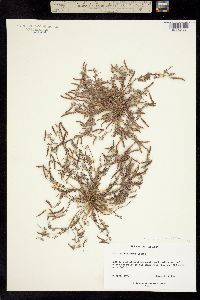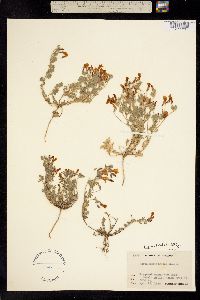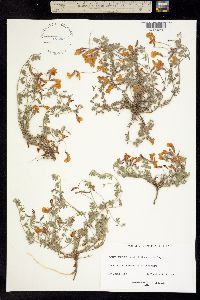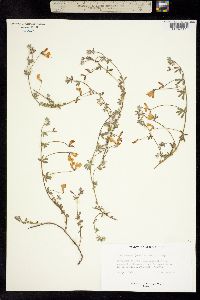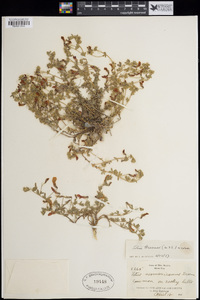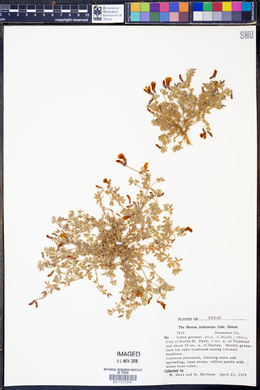Ottleya greenei
|
|
|
|
Family: Fabaceae
Greene's bird's-foot trefoil, more...Greene's Deerweed, deer vetch, Greene birdfoot trefoil, Greene's birdsfoot trefoil
[Acmispon greenei (Wooton & Standl.) Brouillet, moreHosackia mollis , Lotus greenei Ottley ex Kearney & Peebles] |
Lotus greenei is a prostrate perennial that can at times form a groundcover in open dry soil and middle elevation. Lotus humistratus is more densely hairy, and the pods of Lotus humistratus are less than a centimeter long. Lotus wrightii and Lotus purshianus, our other common members of the genus [In the Gila Wilderness], are upright.
Shreve and Wiggins 1964, Martin and Hutchins 1980, Allred and Ivey 2012 Duration: Perennial Nativity: Native Lifeform: Forb/Herb General: Perennial herb from a woody taproot; stems several to many, prostrate and spreading, to 20 cm long; herbage spreading-pubescent with tan to brownish hairs. Leaves: Alternate and pinnately compound, usually with 3-4 leaflets per leaf (sometimes up to 7); leaflets cuneate-obovate or linear-oblanceolate, 8-15 mm long and 3-6 mm wide, with round or pointed tips; densely hairy. Flowers: Yellow, usually in pairs (or clusters of 1-4 flowers) on long peduncles; flowers about 1.5 cm long, with pea-flower morphology (papilionaceous); sepals villous, fused at the base into a tube and topped with 5 narrow long-pointed teeth; corolla yellow to orange or suffused with salmon-pink, 9-18 mm long. Fruits: Pods linear and nearly straight, 2-3 cm long and 2-3 mm wide, hairy; containing several greenish-brown, smooth seeds. Ecology: Found on brushy slopes and dry, rocky plains and hills, from 4,000-6,000 ft (1219-1829 m); flowers March-May. Distribution: sw NM and se AZ Notes: This perennial Lotus can be recognized based on its prostrate, spreading growth form; stems and leaves densely covered with spreading, brownish hairs; relatively large flowers (>1 cm long) and seed pods (>2 cm long); and the number and arrangement of its leaflets. There are usually 3-4 leaflets (or up to 7) in a pinnate arrangement; the leaflets often appear to be palmate, but if you look closely you'll see that at least one leaflet is attached a little lower on the stalk the others. Allred and Ivey list this species as annual, but it is a perennial, though sometimes with a fairly slender taproot so that it perhaps might be mistaken for annual. L. humistratus is another low, spreading Lotus, but it is definitely annual and has smaller flowers (5-6 mm long) and seed pods (5-12 mm long). L. wrightii and L. plebius are also somewhat similar but both are upright plants, with erect to ascending stems Ethnobotany: Unknown Etymology: Lotus comes from the Greek lotos, a plant name with diverse applications in ancient times; greenei honors American botanist Edward Lee Greene (1843-1915). Editor: AHazelton 2017 Martin and Hutchins 1980, Wiggins 1964 Duration: Perennial Nativity: Native Lifeform: Forb/Herb General: Perennial with decumbent to prostrate stems 30-60 cm, with densely villous herbage, tawny or slightly brownish hairs. Leaves: Pinnate with distinct rachis, leaflets 3-7, linear-oblanceolate to cuneate-obovate, rounded and apiculate or acute at the apex, 8-15 mm long, 3-6 mm wide. Flowers: Peduncles much exceeding leaves, 1-2.5 cm long, 1-4 flowered, often with 2 flowers, calyx villous, teeth sometimes longer than tube, corolla 9-12 mm long, yellow on face, suffused with salmon-pink on back. Fruits: Pods densely villous, linear, 20-30 mm long, brown. Ecology: Found on gravelly and rocky slopes from 4,000-6,000 ft (1219-1829 m); flowers March-May. Distribution: s AZ, sw NM; south to n MEX. Notes: Distinguished by being a decumbent or prostrate perennial; the plant copiously long-hairy all over, the hairs spreading or erect; the stalks below inflorescences (peduncles) longer than the leaves; the leaves pinnate but appear palmate and yellow flowers >9 mm which become red after fertilization. Similar to Lotus plebeius but with longer, spreading hairs on the leaves. Ethnobotany: Unknown Etymology: Acmispon comes from the Greek acme for point or hook, while greenei is named for Edward Lee Greene (1843-1915) an American plant collector. Synonyms: Lotus greenei Editor: SBuckley 2010, FSCoburn 2015 |
|
|
|


























